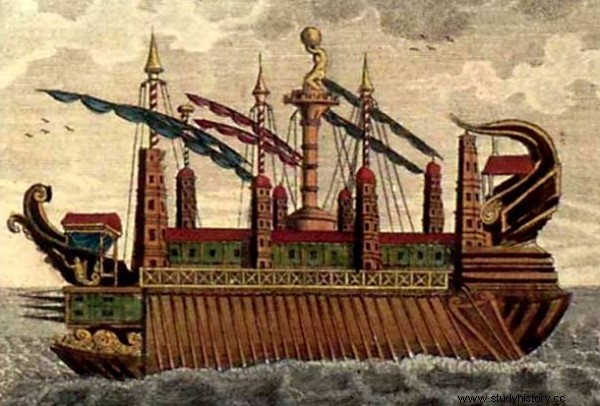Syracuse built by Archimedes in the 3rd century BC she was a real miracle of technology. What happened to the greatest ship of antiquity?
The richest people on Earth compete in ordering bigger and more expensive yachts. Some of the ships sailing on the oceans today could easily be compared to small towns . But this specific "fashion" already existed over two thousand years ago. The rulers of the time dreamed that they would have the largest ship. If one is to believe one of the 3rd century historians, Syracuse was the first in this regard. Built under Archimedes' supervision for a ruler… Syracuse of course, is considered the greatest ship of antiquity.
The birth of a giant
Many great leaders of antiquity could boast ships and ships of spectacular size. Alexander the Great had a nine-row ship, while Ptolemy had a twelve-row ship. But they were nothing compared to Syracuse, the greatest ship of antiquity, built for Hieron the Syracusian by Archimedes. It was supposed to be a twenty-row ship!

photo:Sebastian Ricci / public domain Hieron II, the ruler, or rather tyrant of the ancient city of Syracuse, ordered this miracle of modern technology probably in 250 BC
We find a description of Syracuse in the writings of Athenaeus, who lived at the turn of the 2nd and 3rd centuries. He borrowed it from Moschion, a historian or poet who lived at the time the ship was built. Hieron II, the ruler, or rather tyrant of the ancient city of Syracuse, ordered this miracle of contemporary technology probably in 250 BCE Syracuse was probably built between 240 and 200 BCE. It was probably designed by Archias of Corinth. The construction work was to be supervised by the famous Archimedes.
There were 300 foremen and their assistants working on the construction site. Syracuse was built for a year. To create this ship, enough wood was used to build as many as 60 tetrers. It was necessary to bring this material from various places in the Mediterranean basin - mainly from Sicily and Italy.
Technical parameters of Syracuse
There were three decks in total. It was equipped with three masts and as many as 12 anchors:4 wooden and 8 iron. There were three gangways leading to the ship. The first was used to load goods, the second led to the cabins, and the third was intended for soldiers. The question of the size and weight of the giant raises some doubts. It is difficult to pinpoint these figures exactly. Sometimes there is length:55 meters or 360 feet, which is even more, almost 110 meters. Also the weight of Syracuse was supposed to be impressive:it is estimated at around 2,000 tons!
The ship was so huge that most ports could not take it without risk. For this reason, he could only enter properly in Egyptian Alexandria. So it is also no surprise that Hieron II finally presented Syracuse to Ptolemy III Euregetes. The name of Syracuse was also changed, and it was then called Alexandria or Aleksandris. However, the sources do not agree whether the changes were made by Hieron II or already by Ptolemy III. Most "support" the ruler of Syracuse. Incidentally, the voyage from Syracuse to Alexandria was probably the only voyage that this gigantic ship went on at all. However, he reached the city at the right time. There was grain in his holds, which at that time in Egypt was lacking.
Stables, gymnasium and Iliad
What was on this impressive ship? It is said that it houses: a library, a gymnasium, baths, a temple dedicated to Aphrodite, promenades with flower beds , gardens, kitchens, warehouses. There was a mosaic on the floor depicting the story described in the Iliad . The decks were also decorated with paintings and statues - marble and ivory.

The construction work was to be supervised by the famous Archimedes.
The ship could carry hundreds of passengers (according to one source - 1942 to be exact), soldiers (sometimes their number is estimated at 200) and even horses. There were even supposed to be stables on board. Reportedly, there were 10, or even 10, on each side of the ship. The cargo hold of Syracuse could hold: 60,000 grains, 10,000 barrels of salted meat, 20,000 centners of wool, 20,000 centners of other goods, a considerable supply of food for the ship's crew, including 2,000 buckets of fresh water and cage with live fish . However, the source from which this information is taken has not estimated the tonnage of Syracuse.
Armed to the teeth
Other sources are a bit more careful in their calculations. In one of them the carrying capacity of this vessel is estimated at 2,000 tons. This information is the result of calculations by modern researchers who made them based on the descriptions of the already mentioned Moschion. Or maybe these data refer to the weight of the giant, and its load capacity was much greater? Just like the dimensions, this issue is also difficult to explain. There were also supposed to be around 20,000 gallons / 75,708 liters of water on the ship, and even wooden sea water tanks in which live fish were swimming . Syracuse was also to be equipped with a water pump that could be operated by one man.
It should also be emphasized that Syracuse was probably properly armed. It was primarily armored, which was to guarantee better protection against potential pirate attacks. But she also had offensive capabilities . Its armament was to be a catapult, the ammunition of which was a substantial supply of stones weighing up to 80 kilograms . They could be fired at a distance of up to 180 meters. There were also to be 8 turrets on the upper deck (2 on the bow and stern, and 4 in the middle of the ship) with two archers and four soldiers.
How to launch such a huge ship? Mathematics!
In the context of the history of Syracuse, it is often mentioned that the very enormous challenge was luring this giant. Hieron II was even supposed to publicly challenge Archimedes, asking if he would be able to use mathematics to accomplish what his people had failed? Earlier, he used all his slaves to try to bring the giant to life - but they failed. The famous ancient mathematician was by no means scared. In order to launch Syracuse, he was to build a powerful mechanical structure consisting of many reels and levers.

Artistic vision of Syracuse
To make Archimedes' task more difficult, Hieron II reportedly ordered the ship to be loaded to the brim with all kinds of goods on the day of the challenge. In addition, he placed passengers on board - to increase its weight. This, however, did not thwart the plans of Archimedes, who emerged victorious from this trial. The system he created was to be so comfortable that he could sit in the distance and with one movement of his hand (pulling a rope or a lever) make Syracuse "land" in the waters of the Mediterranean Sea. In this situation, Hieron had no choice. In declaring Archimedes' victory, he stated that we must now believe whatever Archimedes said .
This case, however, is quite controversial. Some researchers believe that a completely different ship was launched in this way or that another heavy object was lowered into the water. We will probably never find out the truth. Nothing j thanks to practically only one mention, Syracuse has permanently entered history as one of the greatest ships of antiquity. And for Archimedes we can add one more success to his already rich "portfolio".
